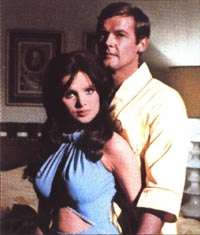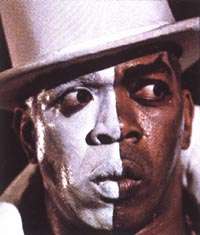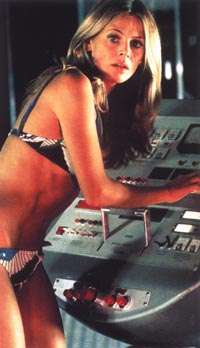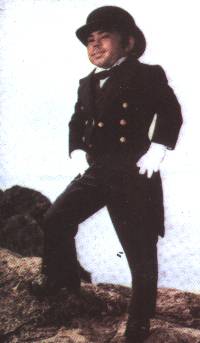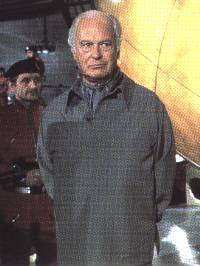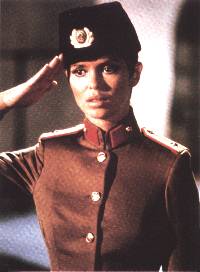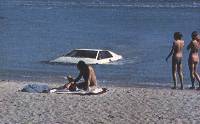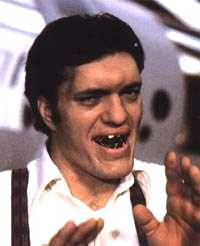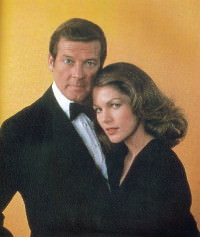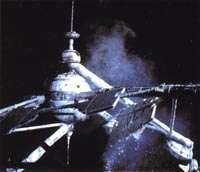| Back to contents -
Before Moore -
Decline and Fall
|
|
|
ROGER
MOORE
IS
| 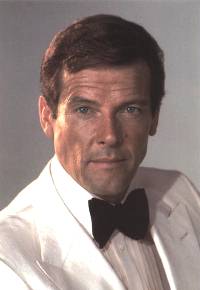
| JAMES
BOND
007
| |
|
| The 1970s saw the Bond films re-invented as a gloriously post-modern
parody of their earlier selves. Effectively, the films now acknowledge
how ridiculous they are, and Bond himself shares the joke with the audience.
The elements of the Bond formula that had slowly developed through the
sixties to reach their culmination in You Only Live Twice - spectacular
science fiction adventures, set in exotic locations and featuring massive
set-piece stunt work - are the staple ingredients of the seventies films.
Roger Moore was the perfect choice to play the reinvented title character.
For a start, he plays Bond with more charm, elegance and class than any of
the other actors to assay the role. His wry humour emphasizes the comic
potential of the Bond series like no one else - the formula effectively
renders any situation, no matter how tense or dramatic, as nothing more than
a feed-line for a raised eyebrow and a humorous quip. |
|
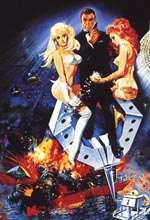
| The first Roger Moore film was Diamonds are Forever - it's
a pity then that the film stars Sean Connery as Bond, lured back to the part
by a ludicrous salary increase. He's as sleazy as ever, and though he goes
along with the humour of the piece, his very presence sits uneasily in this
new style of Bond film. What it needs is Roger Moore! Though the film seems
quite mundane on the surface, being set in and around Las Vegas - hardly an
exotic, unusual Bond location - it's to the director's credit that he plays
up the tackiness and sleaziness of Vegas, with its continual background of
muzak, to make it as strange and alien as any foreign location Bond has ever
visited. The plot itself is pure Bond - Blofeld is using a diamond smuggling
operation to accumulate enough of the precious stones to build a laser
satellite with which he can hold the world to ransom - SDI before its time.
Throw in Bond stealing a moon buggy from a secret lab (in which quite clearly
a Moon landing is being faked in a tv studio) - a billionaire who conducts
his business on the toilet - and even Blofeld in drag - and you have quite
simply the most surreal and insane film in the entire Bond series.
And yet for all that, it has that sense of the exotic, the outrageous and the
downright spectacular that's missing from most Bond films after the 1970s.
| |
|
| It's also incredibly funny. All the sad pedants who accuse
the seventies films of turning Fleming's Bond into a cartoon character miss
the point that these five films are the most consistently entertaining of the
entire series. To pioneer this new direction, the directors of the best
sixties films are brought back - Goldfinger's Guy Hamilton shoots
Diamonds and its successors Live and Let Die and The Man with
the Golden Gun. On all three he is joined by the screenwriter Tom
Mankiewicz, who truly understood the humour inherent in the Bond series, and
how to capitalize on it. With the arrival of Roger Moore, all the elements
were finally in place. Interestingly, considering many fans view Connery as
the ideal and Moore as a lightweight substitute, Roger Moore seems closer to
Fleming's original conception - suave, elegant and upper-middle class. And
yet, a lot of Moore's performance is a veneer - beneath it, he retains a tough
and callous edge - as well as a lot of Bond's caddishness. (Look at his
treatment of Rosie Carver, his rigged seduction of Solitaire, or his shutting
Mary Goodnight in the wardrobe when Andrea comes to his hotel room.) Now, I
don't find this behaviour any more appealing from Moore than I did from
Connery, but his charm and humour count for a lot. |
|
|
| Live and Let Die is, on the surface, quite an ordinary
crime story about drug dealers. Certainly, the voodoo cult subplot is a lot
more interesting than the main narrative. Dr Kananga is a bland villain, but
fortunately he has a great henchman, Tee Hee. The film also contains some
great action set-pieces (all shot through with trademark Mankiewicz humour),
Roger Moore's performance, and some great comedy, including the wonderful
Sheriff Pepper. All this helps it overcome its essentially un-Bond storyline.
|
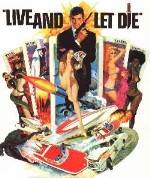
| |
|
|
|
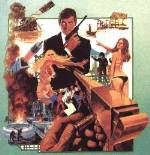
| The Man with the Golden Gun is a vast improvement. All
the good elements of the previous film are reprised (even Sheriff Pepper is
brought back!) - but this time we get a really exotic far East backdrop, and
one of the very best Bond villains, Christopher Lee's Scaramanga, the world's
best hitman who sees himself as Bond's equal. | |
|
|
|
|
| There's a change of creative team for the next two films.
Lewis Gilbert, the director of You Only Live Twice, is brought back,
and teamed with a new writer, Christopher Wood. These two films demonstrate
the absolute pinnacle of the Bond formula. Like Mankiewicz, Wood is a very
funny writer who clearly understands Bond - and Gilbert follows the pattern
of his earlier success to make these the biggest and most spectacular films
in the entire series. The Spy Who Loved Me is plainly the best Bond
film of all. It's got everything: the best pre-credit sequence (Bond skis
off a cliff and escapes by parachute); a villain out to destroy all life on
earth; the best henchman (Jaws); the best Bond girl - Major Anya Amasova,
Russia's top spy and Bond's equal; the best car - a Lotus Esprit that turns
into a submarine. And Roger Moore's finest on screen moment - the look he
gives the beach-goers as he drives out of the sea and drops a fish out of
the car's window. And yet - it falls just short of being absolute perfection
because the villain, Stromberg, is boring and uninteresting. Curt Jurgens
plays the part on auto-pilot, a kind of Bond villain by numbers.
|
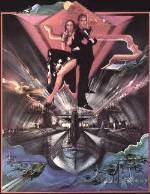 |
|
|
|
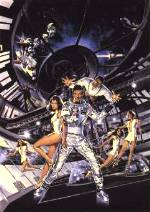
| There is really no such thing as a perfect Bond film - even in
the best of the series, there's always one little thing that brings it down.
Moonraker betters its predecessor by having perhaps the best villain
in the series, Hugo Drax. It brings back Jaws. And Bond goes into space! The
film has been criticized for being a cheap sci-fi flick, designed to cash in
on Star Wars - but this is denying the fact that Bond has always been
science fiction. At this point in the series, Moonraker is merely a logical
development of the Bond formula and the producers' desire to go bigger and
better every time. The real flaw in this film is an occasional lapse into
juvenile humour, notably the scenes involving Jaws and his girlfriend. With a
bit of judicious editing, this one would have been the ultimate Bond film.
| |
|
|
|
| Next page: Decline and Fall
|
|
| Back to contents
Back to Ultra Violet index
|
|


